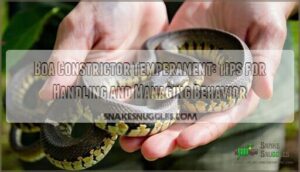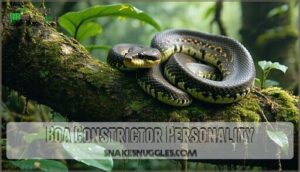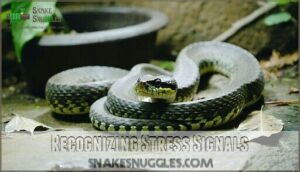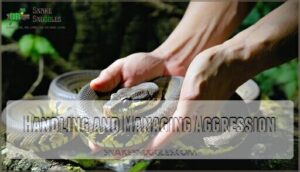This site is supported by our readers. We may earn a commission, at no cost to you, if you purchase through links.

Their temperament varies—most are calm and easy to work with, while others may act defensive if startled or stressed.
They thrive when handled gently and consistently, so avoid sudden movements, as even the sweetest boa can feel threatened.
Stress signs like hissing or hiding mean it’s time for a hands-off approach.
Genetics, environment, and socialization shape their behavior, so proper care is key.
When managed thoughtfully, boas make fascinating companions—just don’t forget: their hugs are for holding, not crushing!
Table Of Contents
- Key Takeaways
- Boa Constrictor Temperament
- Factors Influencing Temperament
- Boa Constrictor Personality
- Recognizing Stress Signals
- Handling and Managing Aggression
- Frequently Asked Questions (FAQs)
- Are boa constrictors friendly?
- Are boa constrictors aggressive to humans?
- Do boa constrictors like to be handled?
- Do boa constrictors bond with humans?
- How difficult is boa constrictor care?
- What are common boa constrictors?
- Are boa constrictors aggressive?
- Are boa constrictors a good pet?
- Can boa constrictors be friendly?
- Is a boa constrictor aggressive?
- Conclusion
Key Takeaways
- Build trust by handling your boa gently and consistently, avoiding sudden movements to keep it calm.
- Watch for stress signals like hissing or hiding, and create a secure, enriching environment to reduce defensiveness.
- Genetics, proper care, and socialization shape their temperament, making them more predictable and manageable.
- Boa constrictors aren’t naturally aggressive but may act defensively if stressed or startled, so approach them with patience and care.
Boa Constrictor Temperament
Boa constrictors are generally calm and curious, but their behavior can vary based on factors like age, handling, and environment.
Understanding their temperament helps you build trust and safely interact with these powerful reptiles.
Behavior Patterns
Boa constrictor behavior reflects fascinating survival traits. These solitary snakes are ambush predators with strategic hunting strategies, lying in wait patiently before striking.
They’re mostly nocturnal but bask during the day. Shedding behavior happens regularly, affecting temperament.
Communication methods include hissing defenses or relaxed tongue flicks. Their predictable activity cycles help manage snake behavior safely.
- Ambush predators, striking swiftly
- Nocturnal with occasional daytime basking
- Solitary except during mating
- Regular shedding impacts behavior
- Communicates through body language
Handling and Taming
How do you build trust with such a powerful creature?
Start with safe handling by supporting the boa constrictor’s entire body.
Taming techniques like slow movements and frequent, short interactions help calm behavior.
Handling frequency matters – aim for balance to avoid stress.
Snake handling gets smoother over time, reinforcing its docile temperament while ensuring bite prevention and mutual trust.
Aggressive Behavior Triggers
Aggression in boa constrictors often stems from prey drive, incomplete shedding cycles, enclosure security issues, or handling mistakes.
Stress from health issues or poor handling can shift their temperament. Always approach calmly and avoid sudden movements during snake handling.
Make certain their behavior is monitored, and their needs are met—it’s easier to prevent triggers than manage aggression.
Inadequate enclosure size can trigger stress responses in boas, leading to potential aggression.
Factors Influencing Temperament
In the case of a boa constrictor’s temperament, several factors shape how calm or defensive it may behave.
Understanding the role of genetics, environment, and nutrition helps you provide the best care while fostering a more predictable and manageable pet, by considering the impact of these factors on the boa constrictor’s overall temperament.
Genetics and Breeding
Snake temperament often stems from morph inheritance and lineage traits influenced by snake genetics.
Selective breeding helps create docile boa constrictors, but hybridization risks can introduce unpredictable behaviors.
Genetic health impacts personality too, as weak genetics may lead to stress or aggression.
Here’s how breeders shape behavior:
- Pair calm snakes.
- Avoid inbreeding.
- Prioritize health.
- Preserve pure localities.
Environment and Socialization
A calm temperament starts with proper space and enriching the enclosure.
Use social interaction to build trust, but don’t overdo handling frequency.
Environmental stressors, like poor space requirements or loud noises, disrupt boa behavior.
Well-placed hides and climbing spots help snake relaxation.
Remember, stress affects snake temperament—think of their enclosure as the ultimate chill zone.
Genetics play a role in boa constrictor docility.
| Factor | Impact | Solution |
|---|---|---|
| Enclosure Size | Stress from tight spaces | Match proper space requirements |
| Enclosure Enrichment | Reduces defensiveness | Add branches and hides |
| Handling Frequency | Impacts trust and stress | Handle regularly but gently |
| Environmental Stress | Causes agitation | Maintain quiet surroundings |
| Social Interaction | Builds calm temperament | Engage patiently |
Feeding and Nutrition
When feeding your boa, stick to frozen-thawed prey that’s no wider than the snake’s body to avoid overfeeding or regurgitation.
Adjust feeding frequency as they grow—every 7-10 days for young snakes, monthly for adults.
Monitor weight to prevent obesity, guarantee hydration needs with a water bowl, and skip unnecessary supplementation unless advised by a vet.
Simplicity keeps them healthy and ensures they thrive with proper care, including a suitable environment and regular checks, which can be summarized as following a simple rule: guarantee hydration needs.
Boa Constrictor Personality
In terms of personality, boa constrictors can surprise you with their range of traits, from calm and curious to shy or defensive.
Understanding these differences helps you handle them confidently and meet their unique needs.
Docile and Friendly Boas
Boa constrictors with calm personalities, often called "Gentle Giants," are known for their docile snake temperament, making them a favorite among beginner keepers.
Docile morphs, like Colombian boas, thrive with regular handling, and over time, these snakes develop a relaxed snake personality, enjoying interaction.
A properly socialized boa constrictor showcases trust, becoming an impressive pet whose boa handling delights its owners, and is a testament to the docile nature of these animals.
Aggressive and Defensive Boas
Dealing with an aggressive boa constrictor can feel like defusing a ticking time bomb, but patience works wonders.
Defensive striking and fear biting often stem from stress.
Here are tips:
- Handle cautiously using hooks or gloves.
- Avoid sudden movements to prevent startling.
- Use taming strategies for consistent interaction.
- Provide hiding spaces for stress reduction.
- Monitor snake temperament regularly.
Shy and Timid Boas
Shy boas often display fearful behaviors like retreating to hiding spots or avoiding interaction.
Patience is key, and gradual taming helps build trust, encouraging docility.
Verify enclosure security, reducing stress triggers, and providing enrichment fosters a calm snake and healthy reptile temperament.
| Behavior | Cause | Solution | Outcome |
|---|---|---|---|
| Hiding often | Stress or fear | Enclosure security | Increased confidence |
| Avoids handling | Lack of trust | Gradual taming | Docility over time |
| Retreating | Unfamiliar environment | Familiar hiding spots | Calm snake behavior |
| Skittishness | Sudden movements | Gentle snake handling techniques | Relaxed temperament |
Recognizing Stress Signals
When your boa constrictor is stressed, its behavior will often signal discomfort, like hissing, hiding, or refusing food.
Being able to read these signs helps you address the problem early and keep your snake healthy and calm.
Hissing and Growling
Hissing and growling are common defensive mechanisms in boa constrictors, signaling discomfort or stress.
These vocalizations, combined with threat displays like puffing up, may sound intimidating but are simply their way of saying, “Back off!”
Individual variation affects reptile temperament, even in normally docile reptiles.
Calm snakes often grow tolerant with patience, proper snake handling techniques, and understanding their unique personality.
Hiding and Withdrawal
A snake’s withdrawal into secure hides is a key response to stress.
Frequent hiding can signal poor enclosure security or unfamiliarity.
Enhance your snake enclosure setup with sturdy snake hide boxes on both ends, encouraging stress reduction.
Monitor behavior changes and hiding frequency to gauge comfort.
Proper handling techniques improve temperament, fostering trust and confidence in their environment.
Loss of Appetite and Weight Loss
If your boa constrictor stops eating or loses weight, it could indicate stress or health issues.
Possible causes include:
- Enclosure Temperature: Too cold or hot disrupts digestion.
- Parasite Infections: Internal problems may affect weight.
- Shedding Issues: A poor shed can stress the snake.
- Underlying Illness: Watch for regurgitation or lethargy.
Stress reduction and regular feeding logs help.
Ensuring proper humidity and temperature is essential for their well-being.
Handling and Managing Aggression
When handling an aggressive boa constrictor, your goal is to approach calmly and prioritize safety for both you and the snake.
Understanding its body language and minimizing stress are key steps to reducing defensive reactions over time.
Supporting The Body
Providing skeletal support while handling a boa ensures the snake feels secure, encouraging docility. Always support its body evenly to prevent strain or injury.
Proper handling guarantees adequate snake support for the animal.
| Key Aspect | Why It’s Vital |
|---|---|
| Skeletal Support | Prevents injury and stress |
| Muscle Strength | Maintains health during handling |
| Hydration Importance | Avoids skin tearing during shedding |
| Shedding Process | Promotes smooth, complete shedding |
| Injury Prevention | Builds trust, creating a handleable snake |
Proper handling guarantees the snake’s well-being and promotes a trusting relationship, which is essential for a positive interaction.
Avoiding Sudden Movements
Sudden movements can make your boa feel like it’s in an action movie—cue the defensive strikes.
Keep your actions slow and predictable, think of it from the snake’s perspective. Calming techniques, like a gradual approach, help improve snake temperament.
With practice, handling becomes smoother, encouraging docility over time. Patience and steady hands go a long way in snake handling tips!
Using snake hooks and tongs are essential handling equipment.
Desensitizing to Handling
Building trust takes patience. Start with a gradual introduction to handling.
Let your boa constrictor get used to your scent—place a piece of worn clothing nearby. Use consistent interaction to create positive associations.
Avoiding stressors like sudden movements helps improve snake docility. Using specialized handling equipment can also increase confidence.
Over time, these small steps enhance your snake’s temperament, making handling smoother and more enjoyable for both of you.
Providing Enrichment and Stimulation
How do you keep your snake’s mind sharp?
Enclosure complexity is key.
Add cork logs, branches, or hides to encourage natural behaviors.
Boost mental wellbeing with sensory stimulation like varied textures or gentle movements in their habitat.
For higher activity levels, offer climbing opportunities.
Consider providing safe enrichment products to further stimulate your boa.
Enrichment reduces stress, improves snake temperament, and helps your pet stay docile and content.
Using Positive Reinforcement Training
Positive reinforcement works wonders for boa constrictor taming.
Use Target Training or a clicker to guide them, rewarding calm behavior with treats.
Shaping behavior step by step builds trust, reduces stress, and improves snake temperament.
For example, rewarding docile handling helps them associate handling with safety.
It’s like teaching a curious, slow-moving student—patience and consistency matter most!
Frequently Asked Questions (FAQs)
Are boa constrictors friendly?
Boa constrictors are generally docile and tolerant, making them suitable companions for experienced keepers.
While young ones may act defensive, with consistent, patient handling, most grow quite tame and even seem to enjoy interaction.
Are boa constrictors aggressive to humans?
Ever met a snake that’s all bark and no bite?
Boa constrictors aren’t naturally aggressive to humans.
With calm handling and proper care, they’re typically docile, though defensive behavior is possible, especially in young snakes.
Do boa constrictors like to be handled?
With regular handling, most boa constrictors get comfortable and tolerate being held.
They aren’t exactly cuddly, but many seem calm in human hands.
Just respect their boundaries, and you’ll have a mellow, manageable snake companion.
Do boa constrictors bond with humans?
Think of a boa constrictor as a calm observer, not a cuddly companion.
While they tolerate handling well with trust, they don’t form bonds like mammals.
They’re more about comfort and familiar routines than emotions.
How difficult is boa constrictor care?
Caring for a boa constrictor isn’t overly challenging, but it’s not beginner-level either.
You’ll need space, commitment, and knowledge of their needs—large enclosures, proper temperatures, and feeding schedules.
Think prepared, not overwhelmed.
What are common boa constrictors?
Common boa constrictors include the Colombian boa (Boa constrictor imperator), known for its docile nature.
The red-tailed boa (Boa constrictor constrictor), is loved for its striking patterns and manageable care requirements.
Are boa constrictors aggressive?
Boa constrictors aren’t naturally aggressive, but they’ll defend themselves if they feel threatened.
With proper handling and care, they typically become calm and docile, even enjoying interaction.
Respect their size and strength for safe interactions!
Are boa constrictors a good pet?
Boa constrictors can make fantastic pets if you’re prepared for their size, long lifespan, and specific care needs.
They’re generally docile, fascinating to observe, and thrive with proper handling, regular feeding, and a secure enclosure, which are all essential aspects of their care.
Can boa constrictors be friendly?
When you treat them right, boa constrictors can be surprisingly social.
With patient handling, they’ll grow calm and tolerate interaction well, even seeming to enjoy it.
Their curious nature makes them fascinating, low-maintenance companions.
Is a boa constrictor aggressive?
A boa constrictor isn’t naturally aggressive, but it can act defensively if startled or threatened.
With proper handling, they’re calm and curious, and tolerate human interaction, making them excellent companions for experienced snake enthusiasts.
Conclusion
Think of managing a boa constrictor’s temperament like gardening—you nurture, adjust, and observe to help it thrive.
By understanding their behavior patterns, avoiding triggers, and prioritizing consistent, gentle handling, you’ll build trust and reduce stress.
Tailoring their environment, paying attention to stress signals, and promoting proper socialization guarantee a well-adjusted pet.
Boa constrictor temperament varies, but with patience and informed care, these fascinating reptiles can become calm, rewarding companions that are as intriguing as they’re unique.










